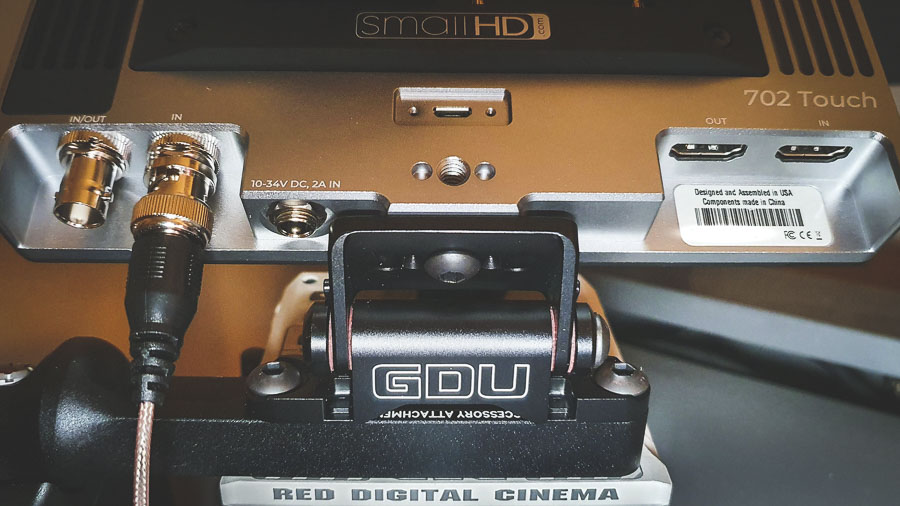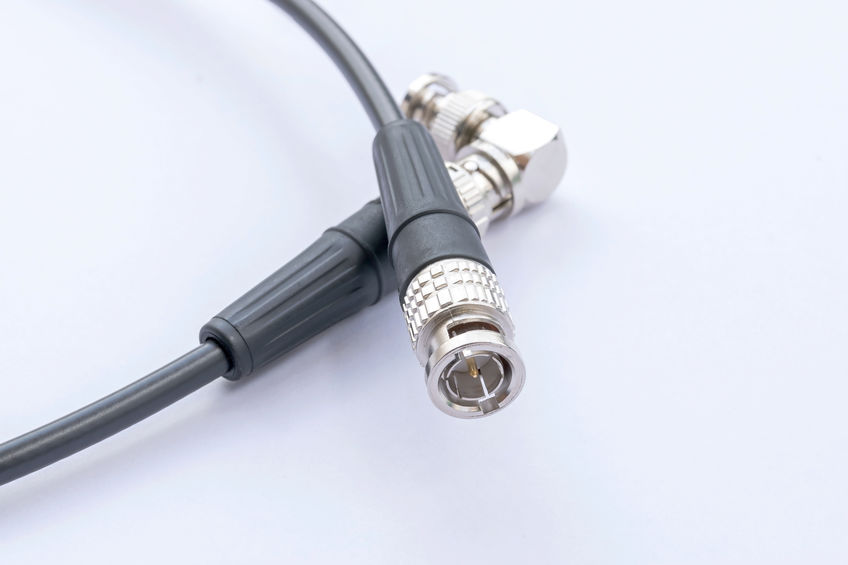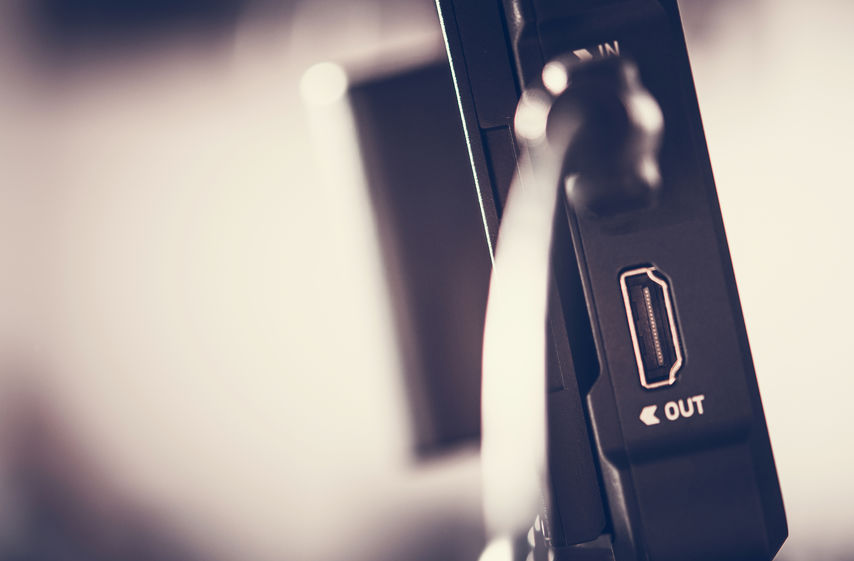Meaning: SDI stands for ‘Serial Digital Interface’ and is a category of digital video interface standards for SDI transferring video, audio, timecode, and metadata in a 75-ohm coaxial cable with BNC connectors. The speed defines each SDI standard. It transports data. For example, a 3G-SDI (3 Gbit/s) can transport 1080p video at 60 fps, while a 12G-SDI (12 Gbit/s) can carry a 4K UHD signal at 60 fps.
Ok, that was the quick explanation. Let’s look at this in more detail below and answer some frequently asked questions about SDI.
Table of Contents
What are the SDI standards commonly used in video and film production today?

SDI is an umbrella term for different standards for transferring video-related data. SDI was first standardized by SMPTE (The Society of Motion Picture and Television Engineers) in 1989.
There are many different standards under the SDI umbrella, e.g., broadcast, stereoscopic (3D) video, dual-link, quad-link, etc., but I’m not going to touch upon all of them here. Also, I’m not going to address interlaced formats.
Instead, I will focus on the standards mostly used for modern digital video cameras to send a signal to an external monitor on top of your camera or to the director on set.
The most commonly used camera standards used by small-scale production companies and indie filmmakers are 3G-SDI and 12G-SDI.
3G-SDI has been the most used professional standard for years, but things are about to change, and I see 12G-SDI becoming the new standard.
Each of these is designed for a specific bit rate and video format. In other words, each can transfer an uncompressed video signal at a specific resolution.
Here’s a table for a quick overview:
| Standard | Name | Bitrate | Video Format | Designed To Carry Up To: |
|---|---|---|---|---|
| SMPTE 292 | HD-SDI | 1.485 Gbit/s | HD-ready, HD, 720p | 1280×720 (60 fps) |
| SMPTE 424 | 3G-SDI 50m+reclock | 2.970 Gbit/s | FullHD, 1080p | 1920×1080 (60 fps) |
| SMPTE 2081 | 6G-SDI 25m | 6 Gbit/s | FullHD, 1080p, UHD, 4K, 2160p | 1920×1080 (120 fps) and 3840×2160 (30 fps) |
| SMPTE 2082 | 12G-SDI 10m + fiber | 12 Gbit/s | UHD, 4K, 2160p | 3840×2160 (60 fps) |
| SMPTE 2083 | 24G-SDI 5m | 24 Gbit/s | UHD 4K, C4K/4K DCI, 8K | 3840×2160 (120 fps) and 7680×4320 (60 fps) |
These are the most commonly used SDI standards in modern cinema cameras today.
The higher the resolution and frame rate the camera can send to an external monitor, the more likely it will have a faster SDI connection.
For instance, the Canon C300 MK iii has HD-SDI, the Panasonic BHG1 has 3G-SDI, and cameras such as the RED Komodo 6K and the Blackmagic Ursa Mini 12K have 12G-SDI.
The Panasonic Varicam can send two 6G-SDI, but 6G-SDI isn’t commonly used.
What SDI output do you need for your on-camera monitor?
Unless you use a 4K monitor or external recorder and your camera can output a 4K signal over SDI, often a 3G-SDI will be sufficient. Most 5″ and 7″ external monitors are only FullHD and will downscale a 4K signal to 1080p anyway.
Regarding 5″ and 7″ monitors, 4K doesn’t make much sense because you can’t see a difference between FullHD and 4K small screens.
But if you were to transmit a 4K signal to a large 4K screen, then 12G-SDI makes a lot of sense. This is especially true if you’re into broadcasting and live streaming since you don’t have to use two or four (dual/quad link) cables to transmit a 4K signal anymore—you can use a single 12 G cable instead.
That’s also why a camera such as the Blackmagic Ursa Mini 12K has a 12g SDI connection for broadcasting and “only” a 3g SDI connection for outputting to an external monitor.
If your camera “only” has 12G-SDI, don’t stress. It is backward compatible so that you can use it with slower standard monitors.
SDI vs HDMI. What is the difference?

SDI and HDMI’s biggest difference is that SDI only transfers raw data, while HDMI transfers image data.
For example, if you transfer the RAW data from the sensor output to an Atomos recorder via SDI, you only transfer the raw data of 1s and 0s. That data then has to be interpreted in the recorder and encoded within the Atomos Recorder so that you can see an image on your screen.
When using HDMI, you send the image data as it is created within the camera.
So which connection is best – SDI or HDMI? And what are the pros and cons of each system?
Benefits of using SDI

The film industry standard is SDI connections because it is generally more stable.
The reason is that SDI consists of a single strand of cable that works as a pipeline for serial digital data. This makes it more stable over longer cable runs and less prone to interference.
Also, the BNC connectors lock the cable in place, so you don’t risk accidentally pulling it out on set.
Limitations of using SDI
Now, SDI also has some limitations.
First of all, SDI is expensive. You pay a lot for the co-ax cable compared to other solutions such as Wi-Fi or fiber.
Second, SDI is heavy – especially compared to fiber-connections.
Third, even though you can use longer SDI cables than HDMI, this doesn’t mean that you can roll out 2km of SDI cable and be fine. And the faster the SDI connection, the shorter the cable you can use for a secure data transfer.
Below, I’ve created a table of the SDI coax cable lengths you can use before boosting the signal with a repeater.
As a rule of thumb, you can expect about half the cable to run when you upgrade one step to a faster standard.
| SDI connection | Max Cable Length |
|---|---|
| HD-SDI | 100m |
| 3G | 50m |
| 6G | 25m |
| 12G | 12m |
| 24G | 5m |
Moving to fiber connections allows you to run the cables much longer. But this is getting into broadcast territory and is beyond the scope of this article.
So if SDI is the industry standard, why would anyone use HDMI? Let’s find out.
Benefits of using HDMI

HDMI became a consumer standard for devices such as television and DVD players to transfer video and audio.
Because HDMI transfers the image data as it is created in your camera, you can send something like a 4K 10-bit HDR or HLG signal over HDMI.
A benefit of HDMI is that both devices are able to “talk” to each other. For example, when you switch on your Apple TV, you can switch on your TV at the same time, because the TV is able to respond to the Apple TV and vice versa.
Because HDMI works both ways, i.e., your camera and your monitor talk to each other, you can control features on your camera via HDMI.
For example, suppose you connect an Atomos recorder to certain Sony, Panasonic, or Canon cameras. In that case, you can press ‘record’ on the camera, and the Atomos recorder will automatically start recording and vice versa.
You can’t do this with an SDI cable without an extra cable or using a timecode tricker.
Fx, on my RED Komodo, I need an extra control cable besides the SDI before I can control the camera from my SmallHD 702 touch. In other words, I need two cables instead of one, which I’m not a huge fan of.
Limitations of using HDMI

Compared to an SDI cable, which is a single thick strand of cable, an HDMI cable consists of several thinner cables that are prone to breaking and interference.
HDMI doesn’t work over longer cable runs. As a rule of thumb, you need to stay below 5 meters—and probably less if there’s a lot of interference from LCD screens, Wi-Fi, etc.
Also, HDMI plugs don’t have locking mechanisms, so they can easily be removed from your camera or monitor unless you buy an extra locking mechanism for your camera cage or monitor.
Summary
So that sums it up.
SDI is the industry standard for serial data interfaces because it provides a more stable connection that is less prone to interference—especially over long cable runs. The locking BNC connectors lock it in place on both camera and monitor, so you don’t accidentally pull it out.
HDMI is the consumer-based standard for transferring video and audio between devices. It’s more prone to breaking, can easily be pulled out of a camera and monitor, and is also more susceptible to interference.
You can get a lot more technical about SDI, and there’s a lot that I’ve left out. However, I hope this has provided useful insight into the pros and cons of using SDI and HDMI in video and film production.
Please let me know in the comment section below if you have any comments or questions.
Up Next: Reasons for using External Monitor-Recorders. A Buyer’s Guide.

